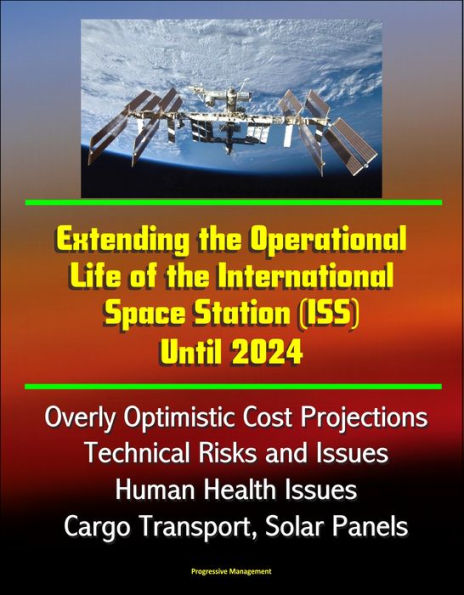This recently released audit report of the NASA Office of Inspector General provides unique information about the challenges facing NASA as it hopes to extend the life of the International Space Station (ISS) through 2024.
Results - We found that while NASA has identified no major obstacles to extending ISS operations to 2024, it must address several areas of risk to ensure continued safe operations. In addition, NASA projects its annual budget for the ISS Program to grow from $3 billion in FY 2014 to nearly $4 billion by FY 2020. However, with a 26 percent cost increase between FYs 2011 and 2013 and an average increase of 8 percent annually over the life of the Program, we believe the assumptions underlying NASA's cost projections are overly optimistic and result in an understated projection of out-year expenses. Third, while utilization of the ISS for research continues to increase, NASA and CASIS continue to face challenges to maximizing its research capabilities.
NASA Has Not Identified Major Obstacles to Extending ISS Operations to 2024 But Several Risks Require Mitigation. NASA continues to assess the long-term viability of the ISS and to date has identified no major obstacles to extending operations to 2024. Nevertheless, the Agency must address several risks. First, the ISS faces a risk of insufficient power generation due in part to faster than expected degradation of its solar arrays. Second, although most replacement parts have proven more reliable than expected, sudden failures of key hardware have occurred requiring unplanned space walks to repair or replace hardware. Third, although NASA has a robust cargo transportation system, it has a limited capacity to transport large replacement parts - such as solar arrays and radiators - to the Station. While the ISS Program is actively working to mitigate these risks, anticipating the correct number and type of replacement parts and transporting them to the ISS present major challenges to extending operations 10 or more years beyond the Station's original expected service life. Additionally, the Program may have to augment the Station's power generating capability due to continued degradation of the solar arrays.
This recently released audit report of the NASA Office of Inspector General provides unique information about the challenges facing NASA as it hopes to extend the life of the International Space Station (ISS) through 2024.
Results - We found that while NASA has identified no major obstacles to extending ISS operations to 2024, it must address several areas of risk to ensure continued safe operations. In addition, NASA projects its annual budget for the ISS Program to grow from $3 billion in FY 2014 to nearly $4 billion by FY 2020. However, with a 26 percent cost increase between FYs 2011 and 2013 and an average increase of 8 percent annually over the life of the Program, we believe the assumptions underlying NASA's cost projections are overly optimistic and result in an understated projection of out-year expenses. Third, while utilization of the ISS for research continues to increase, NASA and CASIS continue to face challenges to maximizing its research capabilities.
NASA Has Not Identified Major Obstacles to Extending ISS Operations to 2024 But Several Risks Require Mitigation. NASA continues to assess the long-term viability of the ISS and to date has identified no major obstacles to extending operations to 2024. Nevertheless, the Agency must address several risks. First, the ISS faces a risk of insufficient power generation due in part to faster than expected degradation of its solar arrays. Second, although most replacement parts have proven more reliable than expected, sudden failures of key hardware have occurred requiring unplanned space walks to repair or replace hardware. Third, although NASA has a robust cargo transportation system, it has a limited capacity to transport large replacement parts - such as solar arrays and radiators - to the Station. While the ISS Program is actively working to mitigate these risks, anticipating the correct number and type of replacement parts and transporting them to the ISS present major challenges to extending operations 10 or more years beyond the Station's original expected service life. Additionally, the Program may have to augment the Station's power generating capability due to continued degradation of the solar arrays.

Extending the Operational Life of the International Space Station (ISS) Until 2024 - Overly Optimistic Cost Projections, Technical Risks and Issues, Human Health Issues, Cargo Transport, Solar Panels

Extending the Operational Life of the International Space Station (ISS) Until 2024 - Overly Optimistic Cost Projections, Technical Risks and Issues, Human Health Issues, Cargo Transport, Solar Panels

Product Details
| BN ID: | 2940046220629 |
|---|---|
| Publisher: | Progressive Management |
| Publication date: | 10/07/2014 |
| Sold by: | Smashwords |
| Format: | eBook |
| File size: | 2 MB |
